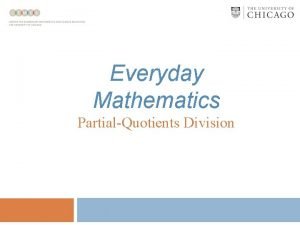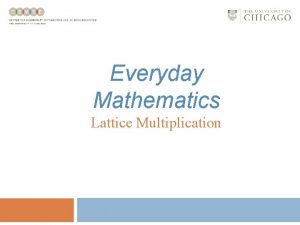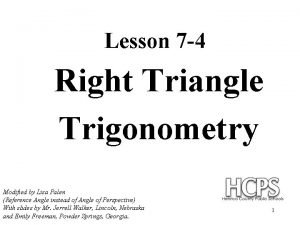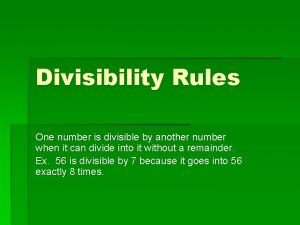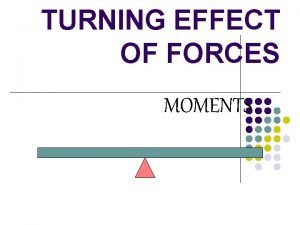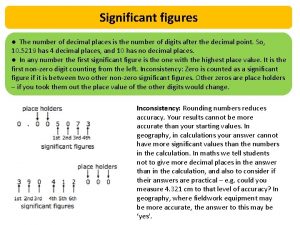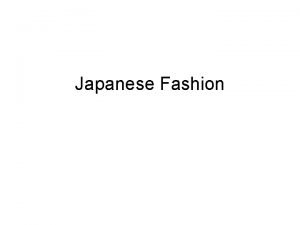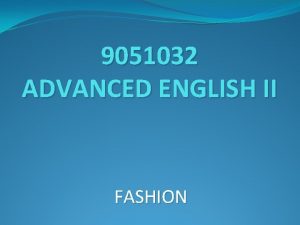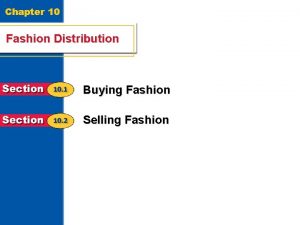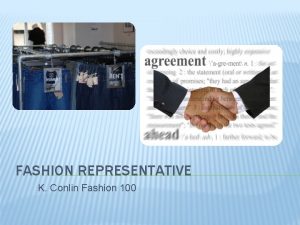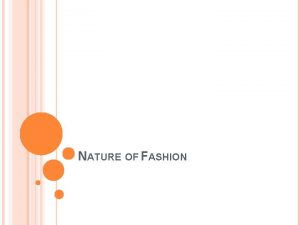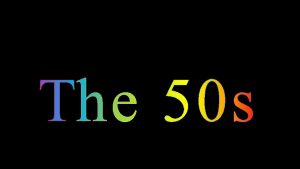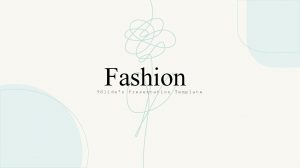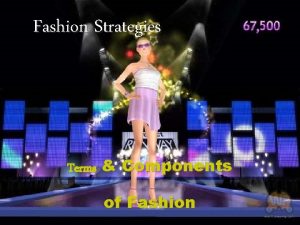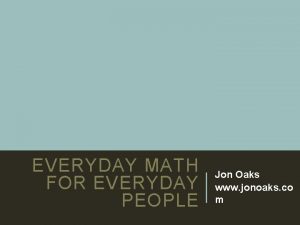How Does Math Work in Fashion Everyday Some


















- Slides: 18

How Does Math Work in Fashion Everyday? Some may doubt that they will ever use math after high school or college, but some industries require having a head for numbers. The fashion industry is not just about clothing, shopping and models; it has a lot of math incorporated into the day-to-day operations.

Measurements are necessary in order to create the clothing. They are vital to making sure the clothes will fit models showing the clothing. Also, it is important that the measurements are tailored correctly for the customers.

Proportion Some outfits are cut in a specific way and designed for a particular type of body. Certain models are chosen to wear particular items based upon their proportions compared to the cut of the clothing. The measurements of the model and the clothing need to coincide, which is where using math comes in.

Inventory � Stores that sell the clothing use math to decide how many of each piece of clothing they want to sell in each store. So as to not have a backlog of inventory, they compare the quantity of pieces sold and the amount that is in stock to what was initially ordered

Return on Investment � When designers buy the materials to create the clothes, they need to make sure that their return is substantial enough to cover all the costs of the initial investment. Math plays an important role in calculating the profit.

Cost of Item Designers need to decide the price of their clothing. In addition, the stores use math to decide how much to charge for the clothing and how and when to discount i

Expenses � Math is used to calculate the amount needed to spend for fabric, hangers, thread and various other items needed in the fashion industry. In addition, calculations also are made to determine production costs to make the clothing.

I New Heights: Combining Math and Fashion- Unitednude A collection of innovative footwear shaped "abstract" as he likes to call the samebrand, a line of sexy shoes and futuristic at the same time glamorous thanks toexclusive concept. Presented at the Paris Fashion Week has been a stunning success andannounced why United Nude is a trademark area, and much loved by young people. Shoes that cover every taste and blend with the needs of everyone. From high heels to comfortable flats and original technology, the entire collection of United Nude is attractive and classy. World famous United Nude and has flagship stores around the globe, luxury retail outlets with a strong visual impact thanks to the technological environment.


Wearable geometry: Amila Hrustic“Platos collection “ The collection consists of five unique dresses handcrafted from a combination of textiles and paper. The main inspiration for the entire Collection is located in Platonic solids. Plato, the great Greek philosopher, studied what we now call “Platonic solids”. No one knows who first described the shapes of these bodies, perhaps early Pythagoreans, but some, including Euclid, say that it was a close friend of Plato’s Theaetetus. � There are only five Platonic solids: tetrahedron, cube, octahedron, dodecahedron and icosahedron. This project examines the concept of geometrically arranged and structured space in relation to the human body. It is the most appropriate to call it a study of perception and contrast, and study of relation between artificial and organic, amorphous and geometric. Each of the five Platonic solids is a basic building element for making dresses. Simplicity of form and use of black and white print patterns on rigid paper emphasize the sculptural collection, its attitude toward the body and overall expression in space. Therefore, Plato’s collection does not fit into the category of everyday fashion and can be considered as a stage costume, and is intended for stage performances, fashion editorials and other special purposes. �


� Theorem of laces And we come to your shoelace. Surely many will have noticed how the newly purchased shoes, are connected in a different way from what you normally use. They leave the store connected in the most simple and faster, but how many know riallacciarle as usual and those who know the difference between the American and European? The three most common ways to fasten your scarpe. A this point intervenes precisely the mathematician or computer scientist at the University of North Carolina, John Halton, which has played an interesting mathematical inquiry, to determine the most convenient in practice requires that the string shorter, to tie the shoes, the three most commonly used in European, or Americanstyle "shoe shop". In this case, to analyze the possible paths from the eye at the top on one side, the cap at the top on the opposite side, with a series of steps through a number of eyelets intermediate. This is actually a classical problem in topology, that of the salesman must visit customers in a number of cities across the country, and then return to his home, following the shortest route and visiting each city only once. In mathematical model the loops become points and the string line. In this way it is possible to calculate the length of the string according to the number n of pairs of eyelets, the distance d between the two eyelets and the gap g between the corresponding eyelets of the right and left. Among the three connections considered by Halton, with n is equal or greater than 4, the shortest is the American result, followed by the European and from that of the shoe store. With n = 3, the �

American is still the shortest, but the European and that of the shoe store are of equal length. The scheme used by Halton, with the path of the tourniquet resulted in a beam of light reflected from specchi. Anche a good student of the medium that I know the Pythagorean theorem is able to solve the problem and show that the American connection is the most convenient Halton, however, had the brilliant idea to match the path of shoelaces, that of a light beam reflected by a series of mirrors. The beam, instead of proceeding in a zig zag pattern, is reflected at each eyelet, in order to maintain a straight path as much as possible. If then the various routes are shown on a rectangular grid, it is easy to verify that the plan is as straight and even shorter than the others. The connections more robust and, right, the cheapest. Bowtie lacing. In Following the work of Halton, a mathematician at Monash University in Australia, Burkard Poster, has decided to resurrect the problem and found that the shortest connection is what has called "butterfly". In his model, Poster considered a diagram with 2 n eyelets with a distance between the two loops of each copy n. Starting to this template poster has discovered that there are many other ways to tie your shoes and rational among them the "Bowtie" is the best, if you request the shortest loop and passing through all the loops. However, the two connections, one American and the shoe store, are the most robust, ie, those that offer a greater force of attraction between the two sides of the shoe. "Hundreds of years of trial and error have led to more robust - say Posters - if not the most efficient tie our shoes. This in front of 51, 840 possible ways to fasten a shoe with just five pairs of eyelets and several million for shoes with a greater number of eyelets. At this point the reader will understand why the mathematician has frequently unlaced shoes, and it rarely leads to the tie. Faced with the task of tying your shoes or to knot a tie, you lose in the analysis of the problem and, if there is not the wife, gets stuck in front of the problem that has too many solutions. It is confusing and does not know which one to choose.

The 85 Ways to Tie a Tie is a book by Thomas Fink and Yong Mao. The authors were research fellows at Cambridge University’s Cavendish Laboratory. It was published by Fourth Estate on Nov 4, 1999, and subsequently published in nine other langua The Book � The 85 Ways to Tie a Tie is about the history of the knotted neckcloth, the modern necktie, and how to tie both. It is based on two mathematics papers published by the same authors in the journals Nature and Physica A The authors prove there are exactly 85 ways of tying a necktie and enumerate them. The Math � The discovery of all possible ways to tie a tie depends on a mathematical formulation of the act of tying a tie. In their papers (which are technical) and book (which is for a lay audience, apart from an appendix), the authors show that necktie knots are equivalent to persistent random walks on a triangular lattice, with some constraints on how the walks begin and end. Thus enumerating tie knots of n moves is equivalent to enumerating walks of n steps. Imposing the conditions of symmetry and balance reduces the 85 knots to 13 aesthetic ones. Knot Representation � The basic idea is that tie knots can be described as a sequence of six different possible moves, although not all moves can follow each other. These are summarized as follows. All diagrams are as the tie would appear were you wearing it and looking in a mirror. Knots � Some useful knots (out of 85 total) described in the book, in order of size, are as follows. The knots are sometimes designated by their number alone (e. g. , FM 2 for the four-in-hand, with FM standing for Fink. Mao). A knot is self-releasing if, when the thin end is pulled out through the knot, no knot is left. A knot is symmetric if the number of L and R moves is equal. � A number of knots have virtually identical variants, which differ by the transposition of L and R pairs. For instance, a variant of the Half-Windsor, Li Ro Ci Lo Ri Co T, is the knot Li Ro Ci Ro Li Co T, sometimes called the co-Half-Windsor. References to the Half-Windsor in the literature sometimes refer to one, sometimes to the other. The Windsor knot has three variants which can be formed by transposing L R pairs.

Fibonacci’s dress “From the serie of Fibonacci Numbers (1 : 2 : 3 : 5 : 8 : 13 : 21 etc. ) this work represents characteristics of the series that is unequal additional increasing. The shape of spiral also come from Fibonacci spiral. Fibonacci also called as a sequence of beauty in mathematic represent. Many Architecture, Design, Painting have some connection with Fibonacci. In Da Vinci Code (Film) also imply about meaning of Fibonacci number. ”


� Fashion design is not sitting at an easel drawing pretty dresses all day, it's a complex job that requires artistic, technical, and business skills. All aspects require arithmetic and math.

Lavoro redatto da: � Battaglia Rossella IV E
 Math partial quotients
Math partial quotients Every day counts calendar math
Every day counts calendar math Lattice box multiplication
Lattice box multiplication Math and fashion
Math and fashion Sometimes you win some
Sometimes you win some Sometimes you win some
Sometimes you win some Cakes countable or uncountable
Cakes countable or uncountable Contact vs noncontact forces
Contact vs noncontact forces Fire and ice diamante poem
Fire and ice diamante poem Some say the world will end in fire some say in ice
Some say the world will end in fire some say in ice Some trust in chariots and some in horses song
Some trust in chariots and some in horses song Some old hippie math
Some old hippie math Numbers divisible by 10
Numbers divisible by 10 Some old hippie math
Some old hippie math In terms of thermal expansion, why is water unusual?
In terms of thermal expansion, why is water unusual? Topmarks
Topmarks Example of turning effect of force
Example of turning effect of force Substitution into expressions
Substitution into expressions What does significant figures mean in math
What does significant figures mean in math
